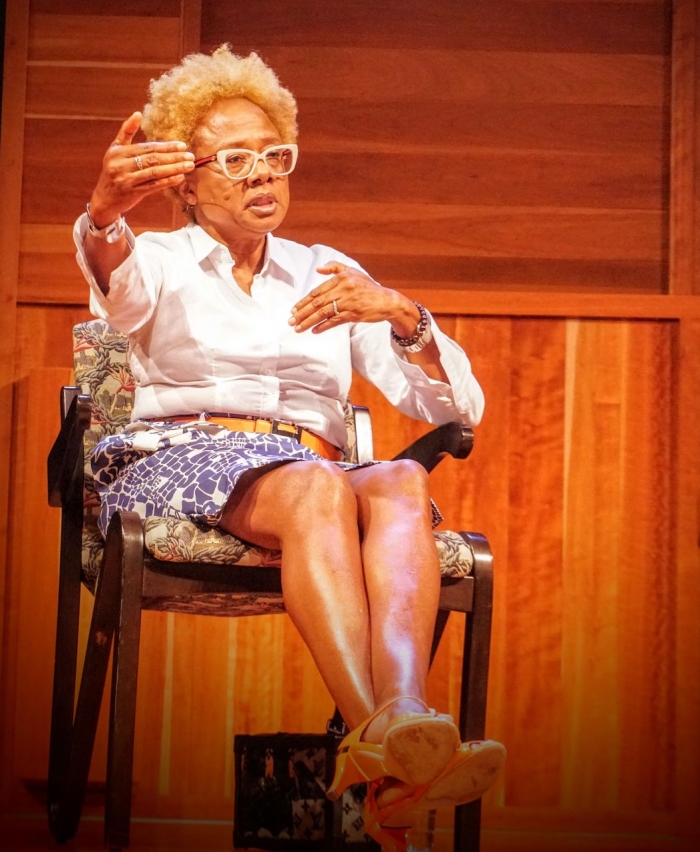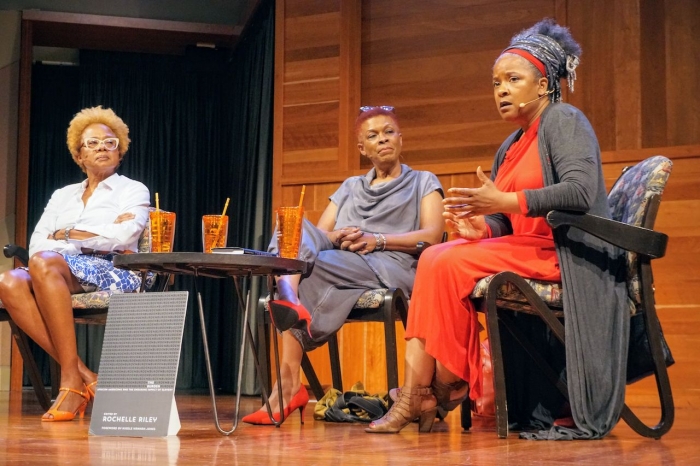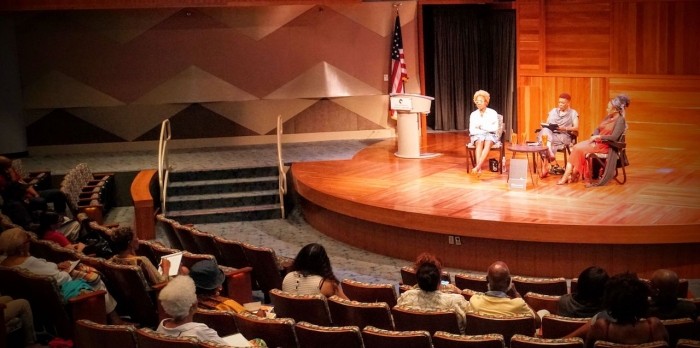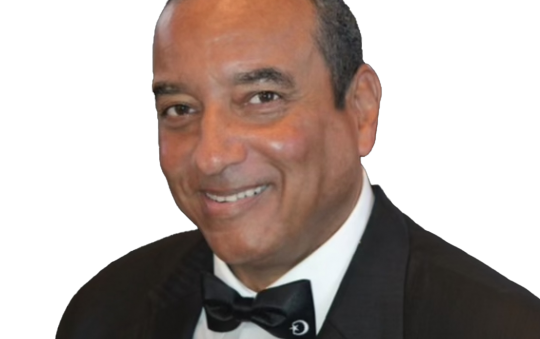
Author Rochelle Riley appeared at Central Library’s Mark Taper Auditorium on July 27 to host a discussion on her book, “The Burden: African Americans and the Enduring Impact of Slavery,” a provocative collection of essays on the long-standing effects of America’s original sin. The former Detroit Free Press columnist was accompanied on stage by journalist Paula Madison and actress T’Keyah Crystal Keymáh, who both contributed essays to the book.
Riley, who recently left journalism to become the Director of Arts and Culture for the City of Detroit, kicked off the event by explaining why she continues to travel across the country with “The Burden,” which was released well over a year ago.
“I continue to have these conversations because we have refused for years and years and decades and decades to talk about enslavement, what it did to our country, what it continues to do to people who are the descendants of the enslaved, and what it does to people who are not the descendants of slaves but still deal with America’s race problem, which as we know not only exists, but is continuing to get worse and worse,” she said.
Riley went on to explain that while she had wanted to write a book on race for quite a while, she was finally galvanized to begin when Pittsburgh Post-Gazette columnist Jack Kelly wrote this in 2015: “Slavery was horrible, but no black American living today has suffered from it. Most are better off than if their ancestors had remained in Africa.” In other words, Black people must simply get over slavery.
“That let me know two things,” Riley said. “One, is he didn’t know any Black people. And two, he had never been to Africa, which is one of the richest continents with amazing countries and great people.”
After reading from the book’s foreword, written by New York Times Magazine investigative reporter Nikole Hannah-Jones, and from the titular essay she wrote for the book, Riley asked her colleagues, “When did you first recognize racism?”
Keymáh told a story from her childhood, when her name was Crystal Walker. A man named Dan Walker was running for governor of Illinois at the time. Believing that he must be her relative, young Crystal Walker told her grandmother that they should be supporting him. Her grandmother told her to have a seat.
“What she told me made me so angry, because I felt like Dan Walker had personally tricked me into thinking that I had a positive alliance with him,” Keymáh said. “I decided in my youth that Black people were labeled in a way that tricked us all into thinking that we were a part of something that we weren’t and that our allegiance should be where it shouldn’t. And I decided to change my name.”
Madison shared a story from her upbringing in Harlem, where she and her brothers were raised by a Chinese-Jamaican mother. She was in first grade, the youngest of three children and the only girl. Her family lived on the north edge of the neighborhood, where she said, “the world could change mightily in the course of walking two blocks.” African Americans were on one side, and Irish, Jewish and German Americans were on the other.

One day, she and her brothers were playing outside when they were approached by a group of White boys. Suddenly, they started yelling the n-word, which Madison had never heard before. She did not know what it meant. Her brothers started screaming “cracker” back at the boys. She was still confused. Madison’s older brother, Howard, turned to her and told her to yell “cracker.” So, she did. She remembers returning home after the encounter and thinking how strange it was. It was not until many years later that the memory dawned on her and she realized what happened that day.
Madison also touched on the fact that her understanding of race and racism was further complicated by the fact that her mother, while half-Black, looked Chinese, and was thus the target of anti-Asian racism on the part of Black people in Harlem.
Then Riley told her story. She was a young girl in the small town of Tarboro, North Carolina, which she describes as having hardly changed since she was growing up. Black people lived on the east side, and White people lived on the west side. For generations, all the Black people had attended W.A. Pattillo, a K-12 school, and Riley was excited to go there just as many people in her family had done. But it wouldn’t go as planned.
“When I was in the sixth grade, it was decided that the way to combat American racism was on the backs of American children,” Riley said. “And we would desegregate the schools, and put the children on buses all the way across town to this other school where we were obviously not wanted, almost not expected, and not expected to last.”
Riley first recognized the existence of racism when she realized that her teachers expected less of her than of the other children in her class. A bright student, she was soon designated as one of the “good” Black children and placed in gifted classes where there were only one or two other Black faces in the room.
“I made friends in that class, but it was very tough for me to like these kids in my class and be friends with them and know that their parents hated me- and our parents,” she said. “I would never go to their homes, I would never have lunch on Saturday, not with any of these kids.”
Fortunately, Riley discovered that she could have meaningful relationships with her White peers.
“The thing that saved me and made me a person who was not hateful and who did not embrace racism was that one of my best friends was Mary Barbe,” Riley said. “She was this geeky White kid who was the daughter of my ophthalmologist.”
Even though they had a wonderful friendship, Riley always felt that they were something of a spectacle in the town, as inter-racial friendships were quite unusual. She remembers every curtain parting whenever she made her way to the west side of town to visit Mary.
“I really did love my friend Mary Barbe, [and] I still do,” Riley said. “But I knew that the relationship we had would always be different than what it could be. And we were always sort of a topic of conversation, and we were odd.”
Despite living in the same small town where everyone knew everyone, Riley says she and her friend lived in two different worlds.
Riley then opened the floor to the audience. Both White people and people of color participated, sharing their earliest discoveries of racism. A White woman recalled an experience she had in college, when other White students threatened to kill her if she made friends with Black people. A Black woman whose mother called her “Queen Nefertiti” described the anguish she felt when she saw her ancestors described as “slaves” in her elementary school history textbooks.
The three women continued to discuss how their understanding of race and racism evolved as they matured.

Madison talked about her college years, during which she wrote her thesis on Marcus Garvey and joined the Nation of Islam. She vividly remembers her Jamaican father’s reaction to finding out she was engaged to a fellow member of the Nation of Islam.
“My father looked at me and said, ‘A Negro? You, my daughter, are marrying a Negro?’” she recalled. “‘They don’t take care of their own children. They piss in their own elevators. They don’t even have their own country.’”
At first, she was confused. Did her father want her to marry a White man?
“‘I want you to marry a Black man,’” she remembers him saying. “‘I don’t want you to marry a Negro.’”
To her father, a Negro was an American Black. Madison retorted, pointing out that she too was an American.
“I was born in Harlem,” she said. “I am a Negro. I will marry a Negro.”
She later realized that her father had acquired a warped view of African Americans as a result of the British colonial education system. Racism, she realized, is taught young.
“It has everything to do with how we’ve been taught to disparage each other,” Madison said. “We didn’t teach ourselves that.”
And schooling is just the first step. As a former police commissioner, Madison saw firsthand the consequences of the school-to-prison pipeline.
“When I learned that the prison industry determines the numbers of prison beds based on the number of Black boys who are in special ed by third grade, that’s not serendipitous,” she said. “That’s a plan. Across the board, every one of us, whether we are U.S. citizens, naturalized or born, whether we are immigrants with papers or not, what we need to understand is that so much of what is going on is a plan. Understand the plan and then bust it up.”
Keymáh discussed similar issues in the educational and criminal justice spheres, beginning with the way Black children are taught their history.

“The word ‘slave’ just makes my skin crawl because it pretends to describe a race of people, but it does not. It describes a condition of a people,” she said. “You automatically denigrate an entire people when you call them their condition, especially when we understand that condition to deplorable and that’s what creates shame in students who learn only the lowest condition of some of their ancestors in school.”
Keymáh also emphasized the point that racism is more than just individuals having negative opinions of other individuals. It is structurally embedded in our society.
“I don’t have the ability to be racist because I am not in charge of a system,” she said. “Every system in this country is indoctrinated, created, runs on White supremacy.”
She said she has become tired of hearing that racism no longer exists, and of having to constantly explain to White people “what reality is.” In some ways, she said, the ignorance is understandable. Like an able-bodied person who walks up to a building a does not have to look for a wheelchair ramp, White people are not paying attention to the system simply because they are content with it as it is. For people of color, the burden of racism is constantly present, but for many White people, it’s invisible.
The myth that racism has somehow vanished from our society is precisely the reason that Riley holds these discussions across the country. Her goal is to show people how slavery persists though it is not nearly as overt as it used to be.
“Slavery did not end,” Riley said. “It just changed addresses. It moved from the plantations to the classrooms, newsrooms, boardrooms, the White House, and courtrooms. And what we do is live with it.”
And Riley would know. She told the audience about how her own daughter once came home from school saying the teacher had told her she would not have to work hard or know as much as other children because she was a minority. The next day, Riley went straight up to the teacher and let her know that she would not tolerate her treating any child differently because of her skin color. From then on, Riley accompanied her daughter to every first day of school all the way through senior year, just to be sure there would never be a similar incident.
What Riley hopes to bring to these discussions is not guilt or shame, but awareness and a call to action.
“There doesn’t need to be an apology; there needs to be a change,” Riley said. “We have to change the way we live, the way we work, the way we govern because have created a system that perpetuates racism. And if we don’t do something about it, we’ll be having the same conversation for the next hundred years.”
When all three women were finished speaking, Riley opened the floor one last time for comments. The last audience member to chime in was a White person. They said they felt compelled to speak to the hope that White people are coming to be aware of their privilege and taking steps to confront it.
“This is a shared burden,” they said. “And some of us who are not people of color are seeing that and doing what we can and stumbling sometimes through. But we are beginning.”






